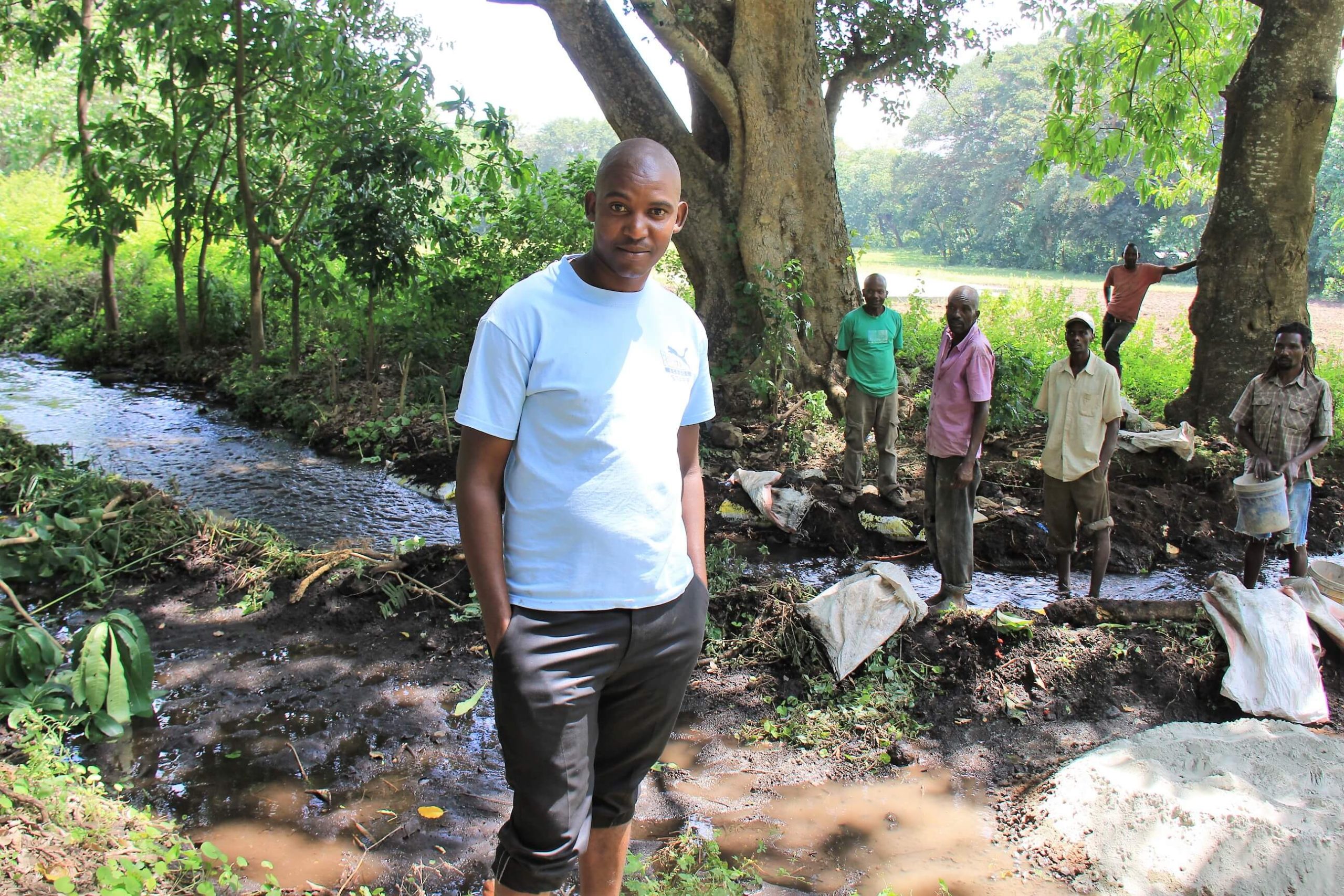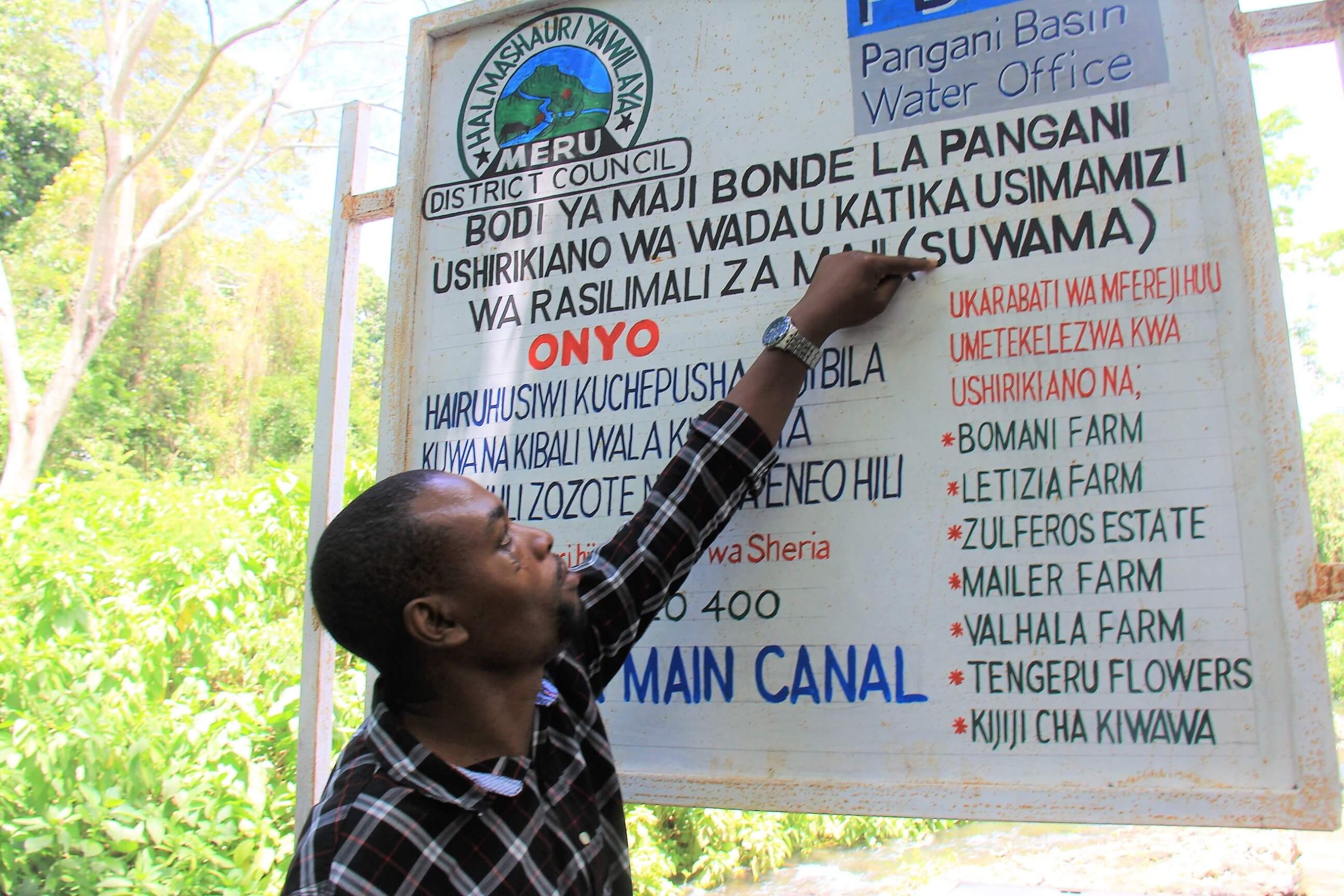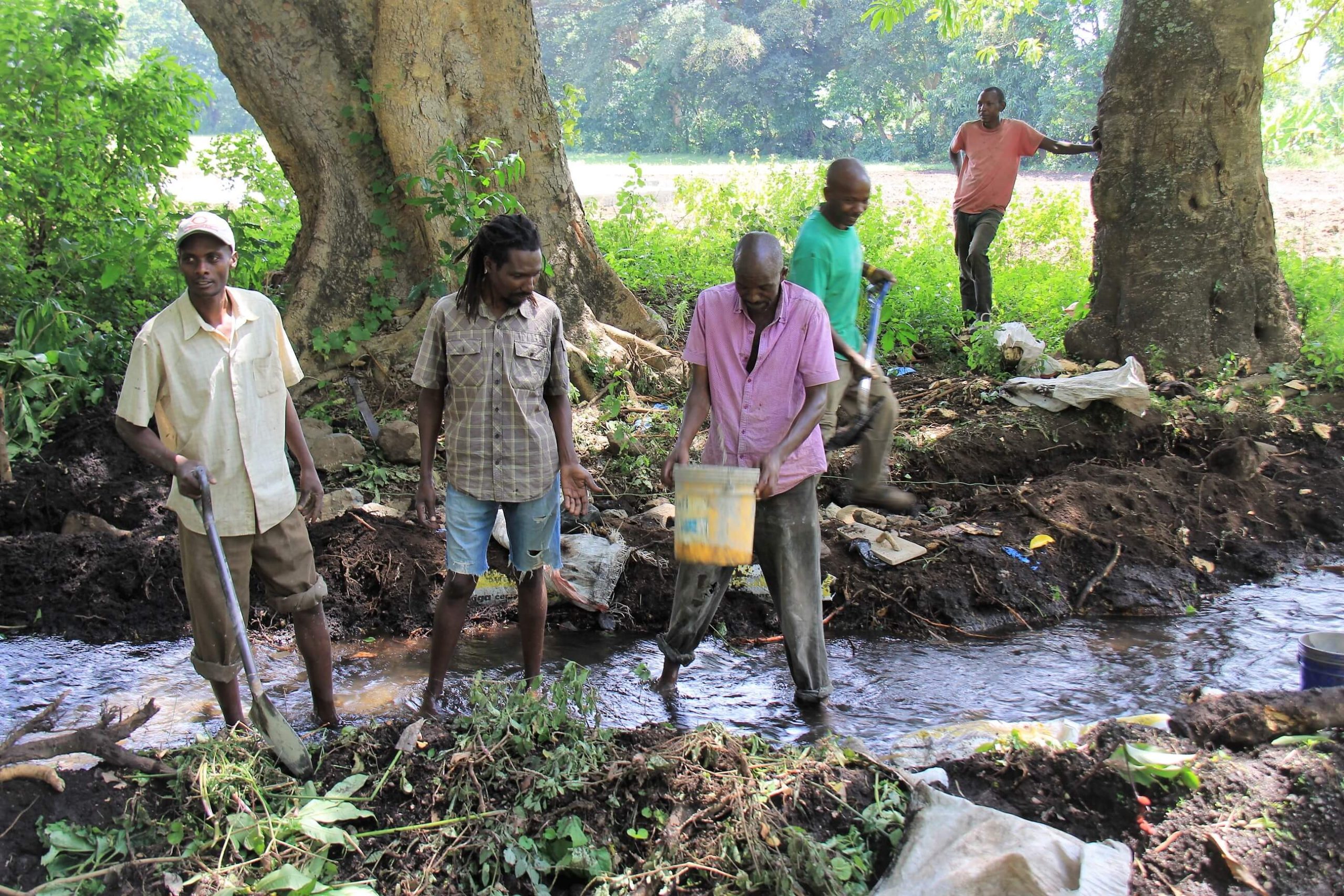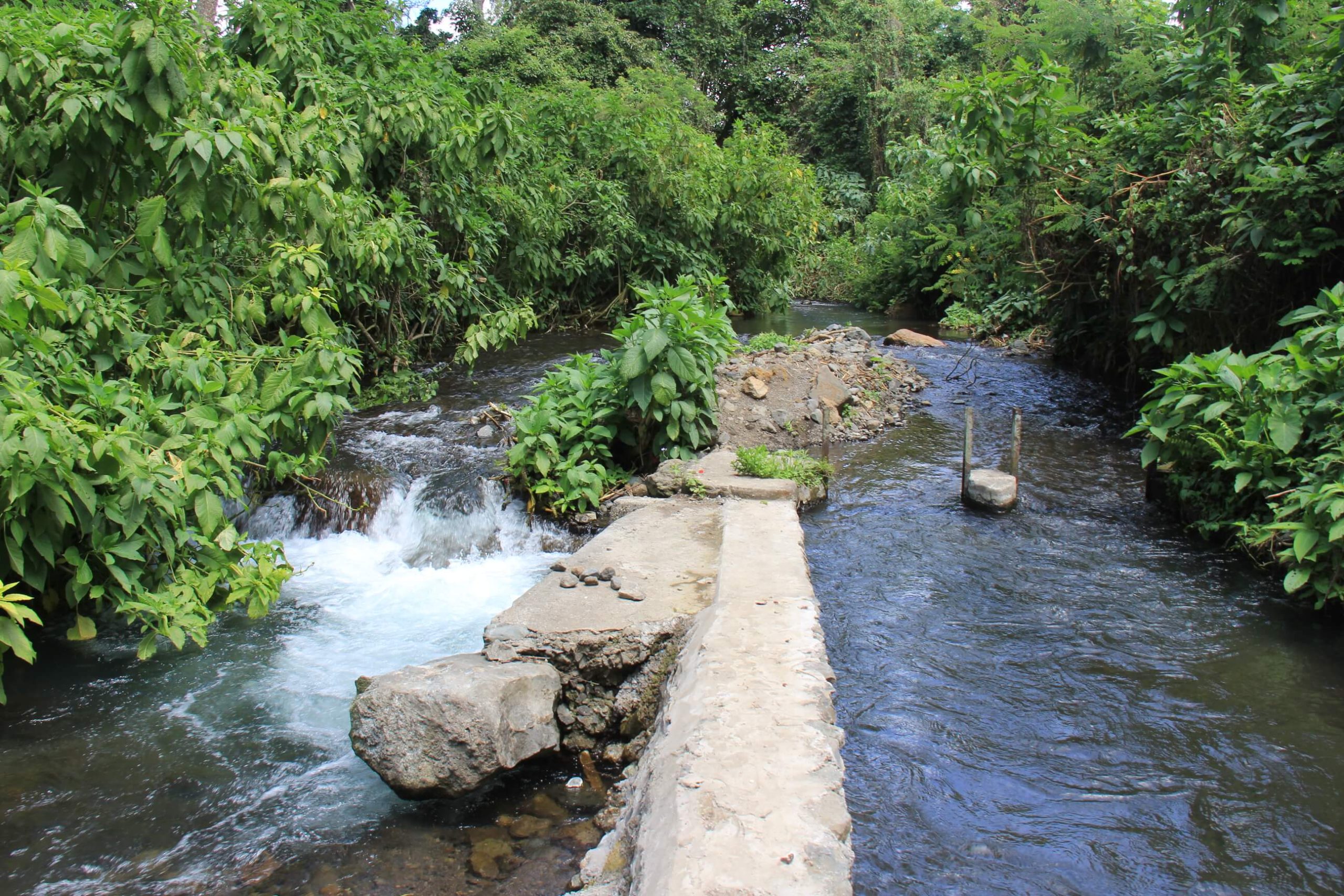Tanzania – Collective action unlocks water for all: the SUWAMA Usa-River Partnership
Climate change, population growth, deforestation, growing numbers of livestock, and the expansion of cultivated land are increasing pressures on the water resources of Tanzania’s Pangani River Basin. A stakeholder-led catchment stewardship initiative launched by 2030 WRG is working to change that narrative.
The first harvest of 2017 was disastrous for Ernest Pallangyo, a farmer and father of two from Kiwawa Village, in Usa River, Northern Tanzania.

Ernest, a smallholder farmer from Kiwawa Village in Usa-River, stands in front of the irrigation canal that supplies his village with water.
Like many small-scale growers, Ernest shares the water allowance allotted under a single water-use permit with neighboring farmers. Back in 2017, when it was his turn to irrigate his small plot of cucumbers, he often found the canal totally dry; others upstream from his village had diverted so much water that there was not a drop left for those downstream.
Eventually, the harsh Tanzanian sun took its toll. His crop withered and died.
To pay for the seeds, the fertilizer, and his portion of the permit, Ernest had taken out a loan. But when his crop failed, he was unable to repay it. In a desperate bid to maintain his relationship with the local creditor, he sold his family’s two goats. The animals that had once been an important source of income – as is custom, his wife reared livestock and sold milk and meat at the local market – and provided his family with milk – an important source of protein in a predominantly plant-based diet – were now gone. There would be no income until the next harvest. Ernest would have go into more debt in order to afford new seeds for the next planting season. The intervening months would be a struggle.
“We are farmers. Our livelihoods depend on water. Without it, we can’t survive,” he explained.
Ernest’s case is typical of the 2.7 million smallholder farmers residing in Tanzania’s Pangani Basin.
As the breadbasket of Tanzania, over three million people derive their livelihoods from the 500 km-long river and the 43,650 km2 of fertile land surrounding it. It is also a vital resource for national economic development. Commercial agricultural interests are growing while three hydropower schemes, located along the main river, have the potential to generate up to 17 percent of Tanzania’s electricity.
But the basin and people who rely on it are in trouble.
Climate change, population growth, deforestation, growing numbers of livestock, and the expansion of cultivated land are increasing pressures on the basin’s water resources. Water flows are decreasing, leading to more intense competition among water users and dire consequences for families whose livelihoods depend on the land—families like Ernest’s.
“Agriculture is the backbone of Tanzania’s economy” explained Angelina Nyamsambo, Agri-Finance Officer with the Tanzania Horticultural Association.
Agriculture generates around 30 percent of GDP, accounts for 28 percent of exports, employs 66 percent of the population, and is the mainstay of 80 percent of livelihoods in the country.
“Poor access to water reduces farmers’ productivity, limits their income, threatens food security and ultimately results in lower GDP” stressed Angelina.
But effective water management is a complex and volatile issue. Increasing competition for water among riparian stakeholders, each with varying degrees of access to water infrastructures like irrigation and storage, is complicated by the local politics of water allocation.
Weak monitoring and enforcement of regulations designed to control and protect water resources, alongside a general lack of awareness about efficient water use and sustainable farming practices and ineffective coordination among stakeholders further compound the challenge of fair and equitable water delivery in the sub-catchment.
Sustainable water resource management is a challenge nationwide. A recent Tanzania Economic Update, published by the World Bank, found that sub-optimal water management is already having a negative impact on Tanzania’s economy.
To strengthen collaborative approaches to water management in the country, Tanzania 2030 Water Resources Group (2030 WRG) – a public-private-civil-society partnership hosted by the World Bank Group – has been working with government and businesses to identify, develop and scale innovative solutions to the country’s water management challenges since 2013.
The Sustainable Water Management (SUWAMA) Usa-River Partnership is a stakeholder-led catchment stewardship initiative launched under one of Tanzania 2030 WRG’s flagship initiatives—the Kilimanjaro Water Stewardship Platform (KWSP)—that has been carrying out successful joint initiatives among public institutions, community organizations, and businesses to address water-related challenges in the sub-catchment since 2016.
Led by the Pangani Basin Water Board (BWB), in partnership with KWSP, the Gesellschaft für Internationale Zusammenarbeit (GIZ) through the International Water Stewardship Programme (IWaSP), the Upper Kikuletwa Water User Association (WUA), the Tanzanian Horticulture Association (TAHA), and Kiliflora Limited, SUWAMA engages water users all the way down to the village level.
The partnership focuses on improving water governance, water use efficiency, and water quality and supply, and works with the community to collectively identify priorities and strategies to do so.
“Our approach is based on the recognition that working separately is a risk for all users because they share the same water source. This means that all the different users need to get together and act collectively in order to help each other and themselves,” said Abraham Yesaya, Community Development Officer with the Pangani BWB, who manages the SUWAMA partnership.

Richard Johannes, Project Officer for the Kilimanjaro Water Stewardship Platform, believes that community ownership is key to SUWAMA’s success.
According to Abraham, the most challenging aspect of the partnership was the initial period of community mobilization and coordination. But it has also provided the biggest payoff. “People need to own the project, otherwise nothing will ever be completed,” he said. “In this case, they do [have ownership], and it shows.”
The collaboration is a model of community-scale public-private cooperation, with private sector partners providing over half of the total financing. Other private sector partners have provided in-kind assistance, such as farming inputs, trees for rehabilitating damaged riparian land, and supplies for the reconstruction of dilapidated irrigation systems. Meanwhile, community members contribute their time and skills. Information placards placed at project sites recognize the contributions of local village associations alongside those of donors and private sector partners. Everyone is in it together.
After two years in operation, satisfaction with SUWAMA’s collective action approach is high.
Rogers is a transplant from South Africa who lives on a lush 90-acre piece of land that used to be a coffee plantation. Of those residents receiving water from the Usa-river, he is among the furthest downstream to be connected to its system of irrigation canals and farrows. Before SUWAMA, he recalled periods of up to six months during which no water flowed to his farm. Today, it flows without disruption.
“It doesn’t matter how much money or what kind of sophisticated technology you throw at the problem; it’s about people,” emphasized Rogers. “You need to get people together and get disciplined.” He hopes to see the model replicated in other communities.
To date, the partnership has succeeded in improving water security for more than a quarter of a million people living around Usa-River in the Kikuletwa Catchment, Pangani Basin: 25,000 people have received direct assistance through SUWAMA, while a further 800,000 have benefited from improvements in water access as a result of the partnership’s initiatives.
Back in Kiwawa, a project to address the source of the village’s water challenges is nearing completion. As part of its good water governance workstream, SUWAMA convened water users from upstream and downstream to collectively assess why there was insufficient water during certain parts of the year. They found that in addition to illegal abstractions occurring upstream, a significant amount of water was lost because the canals, and especially the farrows and abstraction points, were in a state of disrepair.
Since then, a community task force that was created to address these issues has been overseeing efforts to improve monitoring of water use in coordination with the Pangani BWB. The task force, part of the local Water Users Association, has also developed a constitution and bylaws to govern water use and launched a canal rehabilitation project that will prevent future water losses.

Members of a community task force convened by SUWAMA work together to improve the canal infrastructure leading to their village.
With funding from a consortium of water users from the community, a reconstruction of the primary diversion point from the main Usa-river canal has already been completed. Next-up is the abstraction point from which Kiwawa draws its water. Overseeing construction is Ernest, who now serves as Chairman of the Kiwawa Irrigator’s Association.

The reconstruction of the primary diversion point from the main Usa-river canal was among the first projects completed by SUWAMA.
He is looking forward to what he and his neighbors will be able to achieve with consistent and reliable access to water. For him and his family, he envisions green irrigated plots and abundant harvests. Maybe even a greenhouse for himself, with two goats tied up out front.
